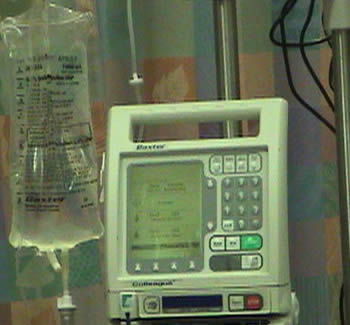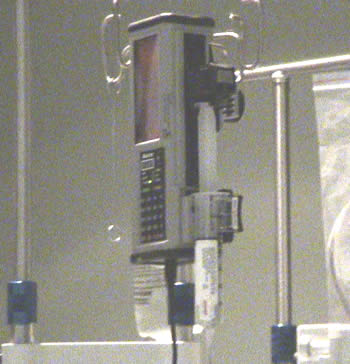|
INFUSION PUMP Many of the drugs used during critical illness are very potent. Change in the rate of administration by only a few ml per hour can have very large effects. Patients often have several different medication infusions running at the same time. Consequently, accuracy in the delivery of fluid and medications is very important. To ensure accurate fluid and medication administration, infusion pumps are used to delivery intravenous therapy. An infusion pump draws fluid from a standard bag of intravenous fluid and controls the rate of flow. It provides accurate and continuous therapy. Because it can use any size bag of intravenous fluid, an infusion pump can be used to deliver fluids at either a very slow or very fast infusion rate. Some pumps are able to control a single intravenous line, whereas, other infusion pumps have 3 pumps built into one device. These "triple pumps" are used to save space. A syringe pump is a different type of infusion delivery device. Instead of drawing fluid from an infusion bag, intravenous medications are drawn into a syringe and installed into the device. Because syringe pumps contain a maximum volume of 50 ml, syringe pumps are used to administer medications that have very small hourly volumes (for example, usually less than 5 ml/hr). If the hourly volume requirements increase, an infusion pump is generally used to deliver the medication. Syringe pumps are more compact and take up less space than infusion pumps. This becomes important when the patient is on many different infusions. If a patient has very high fluid requirements, or is cold (hypothermic), a special infusion pump with a built in heater can be used. This device is used most frequently in trauma patients who are cold and need large amounts of fluid and/or blood products. |
Image 1: Infusion Pump |
|
Image 2: Syringe Pump |
|
|
|
|
|
|
|
|
|
Our masking guidelines have been updated. Visit the Patient and Visitor Masking Guidelines page for more information.





